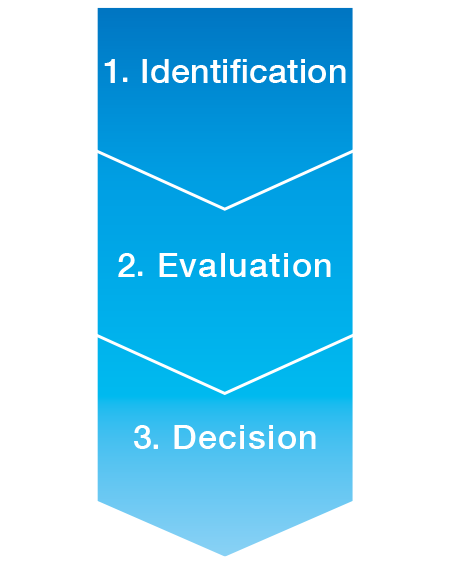Materiality - Identifying Priority Management Themes for Sustainability
"Materiality" represents the key management themes identified through a Materiality Assessment. This assessment helps us set sustainability goals, mitigate risks, and prioritize identified issues.
Criteria and Process for Selecting Material Themes
- Identifying societal challenges related to achieving the company goals:
• Considering relevance to the company motto and management philosophy, especially based on the principles of the Shimadzu Group Sustainability Charter: Shimadzu Group Sustainability Charter:SHIMADZU CORPORATION
• Considering relevance to Shimadzu‘s business areas and value chains. - The Double-Materiality Assessment
• Evaluating and prioritizing themes based on two evaluation parameters:
1) Influence of Shimadzu Group‘s activities on society.
2) Impact on the company‘s corporate value. - Deciding on key material topics and initiatives:
• Determining key material topics in the mid-term management planning process.
• Setting and reviewing KPIs and initiatives annually during Shimadzu Group‘s Sustainability Meetings to ensure that targets and initiatives are effective and on track.

Current Material Themes
Shimadzu Group has determined the following 7 material themes through the Shimadzu Group Sustainability Management Implementation Policy, and the topics addressed for each materiality are linked to the medium-term management plan.

Setting and Evaluating Materiality-based KPIs
We set our KPIs based on each materiality topic every year and evaluate the results at the Shimadzu Group Sustainability Meeting.
Based on the premise that challenging KPIs will be set in the annual review, the target value of the Shimadzu Sustainability Score, which is the average of KPI achievement, is set at 90%.
In FY2023, a total of 54 KPIs were set for seven materialities, and the Shimadzu Sustainability Score achieved more than 90% of the target value.

Current Selected Targets and KPIs Based on Materiality
The Shimadzu Group‘s main targets and KPIs are set out in the "Materiality" section of the Annual Integrated Report.


